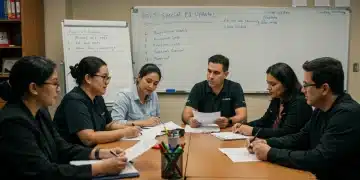Teacher training grant cuts: what they mean for education

Anúncios
Teacher training grant cuts significantly impact the quality of education by limiting resources and support for aspiring educators, which ultimately affects student learning outcomes.
Teacher training grant cuts are making waves in the education sector, affecting everything from recruitment to classroom quality. Have you wondered how these changes might shape the next generation of educators? Let’s dive in.
Anúncios
Understanding teacher training grants
Understanding teacher training grants is essential for anyone involved in education. These grants provide financial support to individuals seeking to become teachers. They help cover tuition costs, textbooks, and other expenses associated with gaining a teaching qualification.
Grants are typically awarded based on need or merit, helping to increase the number of qualified educators in schools, especially in underserved areas.
Types of Teacher Training Grants
Several types of grants exist, tailored to different needs:
Anúncios
- Federal Grants: These are offered by the U.S. Department of Education and can cover significant costs.
- State Grants: Many states offer their own grants for teacher training to address local educational needs.
- Private Scholarships: Organizations and foundations also provide funding for aspiring teachers.
To learn more about the various grant options, visit the U.S. Department of Education for the latest information and resources.
| Aspect | Purpose | Example/Insight |
|---|---|---|
| Training Grants | Support aspiring educators financially | Federal, state, and private options |
| Historical Funding | Track evolution of grant support | Title II, HEA, performance-based models |
| Budget Cuts | Identify impact on teacher programs | Fewer workshops, materials, opportunities |
| Recruitment Impact | Analyze challenges in hiring teachers | Fewer applicants, larger class sizes |
| Alternative Funding | Explore new support sources | Scholarships, crowdfunding, NEA grants |
| Student Feedback | Understand future educators’ needs | Call for mentorship and flexibility |
| Advocacy Voices | Highlight calls for restored funding | Support for diversity, quality outcomes |
| Future Outlook | Adapt to funding and policy shifts | Collaboration, tech, community support |
Historical context of grant funding
The historical context of grant funding reveals how financial support for teacher training has evolved over the years. Initially, funding for education came mainly from local taxes and private donations. However, as the need for more qualified teachers grew, governments recognized the importance of grants.
Federal initiatives, such as the Higher Education Act of 1965, introduced significant funding that targeted the education sector. This legislation aimed to increase access to higher education and support for teacher training programs.
Key Milestones in Grant Funding
Several key milestones have shaped the funding landscape:
- 1970s: Introduction of federal grants like Title II, aimed at improving teacher quality.
- 1980s: Expansion of state-specific programs to address local educational needs.
- 2000s: Emphasis on performance-based funding and competitive grants for innovative teaching methods.
For more about the evolution of funding in education, check the U.S. Department of Education for comprehensive resources.
Current budget cuts and implications
Current budget cuts in education are having significant implications for teacher training programs. Many schools are facing reduced funding, which impacts their ability to support aspiring teachers. These budget cuts can lead to fewer available resources and training opportunities.
As a result, important programs might be cut or limited. This challenges the development of future educators and affects the overall quality of education.
Key Implications of Budget Cuts
Some implications of these cuts include:
- Fewer Workshops: Training workshops that enhance teacher skills may be discontinued.
- Limitations on Resources: Access to necessary teaching materials and technology can be restricted.
- Impact on Recruitment: Challenges in attracting new teachers to the profession due to reduced support.
To understand more about the effects of budget cuts in education, refer to the U.S. Department of Education for official updates and findings.
Impact on teacher recruitment
The impact on teacher recruitment due to funding cuts is significant and concerning. When budgets shrink, schools often struggle to attract new, qualified teachers. Financial incentives, programs, and resources are key factors in drawing talent to the profession.
Many aspiring educators may choose other careers due to the lack of support and limited opportunities. This trend can lead to a shortage of teachers in critical areas, which affects student learning.
Consequences of Reduced Recruitment
Some consequences of limited teacher recruitment include:
- Increased Class Sizes: With fewer teachers, classrooms become overcrowded, which makes learning challenging for students.
- Shortage of Specialized Educators: Subjects like science, math, and special education may face a scarcity of trained teachers.
- Quality of Education Declines: A lack of qualified teachers can lead to poorer educational outcomes for students.
For insights into how teacher recruitment is evolving, visit the U.S. Department of Education for more information and resources.
Alternative funding sources for training
With recent cuts in educational budgets, exploring alternative funding sources for training has become essential for aspiring teachers. These alternative sources can provide much-needed support to help navigate the financial challenges of entering the teaching profession.
Many organizations and foundations offer grants, scholarships, and other forms of financial assistance specifically for future educators. Discovering these options can broaden access to necessary training.
Types of Alternative Funding Sources
Some alternative funding options include:
- Private Scholarships: Many organizations fund specific scholarships for students pursuing teaching degrees.
- Crowdfunding Platforms: Educators can create campaigns on platforms like GoFundMe to raise money for training expenses.
- Professional Associations: Groups such as the National Education Association (NEA) often offer grants and financial aid to teacher candidates.
For a comprehensive list of funding options, check the U.S. Department of Education.
Student perspectives on training changes
Understanding student perspectives on training changes is crucial as it sheds light on how recent developments are impacting future educators. Students often have unique insights regarding their experiences in teacher training programs and what they need to succeed.
These perspectives can highlight the benefits of current training models, as well as the challenges posed by funding cuts and changes in curriculum.
Key Insights from Students
Some common themes from student feedback include:
- Need for Practical Experience: Many students emphasize the importance of hands-on training and classroom experience.
- Desire for Support: Students often seek mentorship opportunities to guide them through their training.
- Flexibility in Learning: A growing demand for online resources and flexible class schedules is noted.
To explore more on student perspectives and feedback, visit the U.S. Department of Education for further insights.
What advocates are saying
Understanding what advocates are saying about teacher training grant cuts provides valuable insights into the ongoing conversation around education funding. Advocacy groups are raising their voices to highlight the consequences of these cuts on future educators and students.
Many advocates argue that these cuts will lead to a decline in education quality, as fewer resources mean less support for teacher preparation programs.
Key Points from Advocacy Groups
Some key points from advocates include:
- Need for Increased Funding: Advocates emphasize the importance of restoring and increasing funding to teacher training programs.
- Support for Diverse Educators: Many believe funding cuts disproportionately affect efforts to recruit diverse candidates into teaching roles.
- Long-term Impact on Students: The quality of teacher training directly influences student outcomes, which advocates stress should not be overlooked.
For more information and perspectives from advocacy groups, visit the U.S. Department of Education for further resources.
Future of education amidst grant cuts

The future of education amidst grant cuts poses significant challenges and uncertainties. As budgets decrease, schools and educational programs must adapt to maintain quality in teaching and learning.
Teacher training programs are particularly vulnerable, making it vital for educational institutions to seek innovative solutions to support aspiring educators.
Adjustments in Educational Approaches
To navigate the challenges posed by funding cuts, several adjustments may be necessary:
- Increased Collaboration: Schools may partner with community organizations to share resources and provide support.
- Utilization of Technology: Online training and resources can help reach a broader audience while minimizing costs.
- Advocacy for Funding: Educators and advocates must continue pushing for increased funding and grants to support teacher training.
For more information on the evolving landscape of education funding, visit the U.S. Department of Education for updates and resources.
The Future of Education is in Our Hands
As we navigate the impacts of teacher training grant cuts, it is clear that the future of education depends on our collective efforts. Educators, advocates, and communities must work together to find innovative solutions to funding challenges.
By exploring alternative funding sources and emphasizing collaboration, we can continue to support aspiring teachers and maintain educational quality. The conversation around education funding must remain active to ensure that all students receive the quality education they deserve.
Ultimately, it is our responsibility to advocate for the necessary resources, ensuring that future generations of educators are prepared to inspire and lead.





